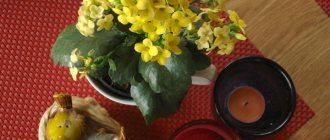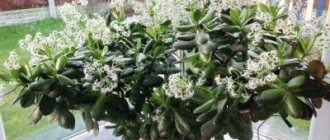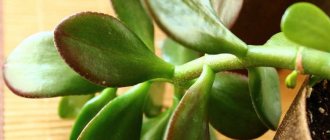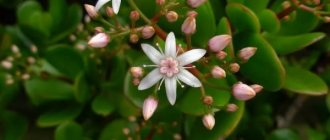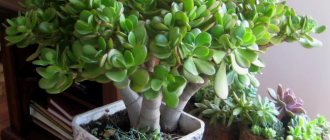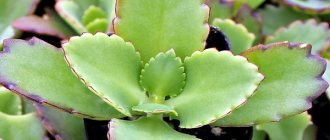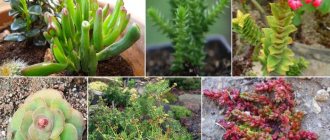It is even believed that this tree brings good luck and money to the owners’ house and has positive energy.
The height of this tree can vary: from three centimeters (dwarf species) to five meters. The life expectancy of the fat plant depends on the conditions in which it is grown. If the grower does everything correctly, it will delight its owners for many years, without changing its color, but only increasing in size. There are plants that live even up to fifty years.
This is one of the most unpretentious and picky flowers , it has a strong immune system, but still it is susceptible to some diseases. The leaves of this tree are most often affected. Read more about the reasons for dropping leaves here.
How to save a money tree
Improper care of Crassula Morgana, a houseplant, increases the risk of ailments, which must be immediately addressed and quickly eliminated. You can save a fat woman if you know the reason for its poor condition. The most common problems that gardeners face are loss of leaf elasticity, a broken thin trunk, and the appearance of red, black or white spots on the flower.
For a tree to always be so majestic, it requires special care.
Why did the money tree start to fall and its trunk break?
There are several reasons why the fat plant loses its stability.
- The crown of the plant is incorrectly formed. The money tree tends to grow. Growth is especially strong in spring and summer, causing the top of the Crassula to become excessively heavy compared to the rest of the plant. This not only spoils the appearance of the money tree, but also causes it to fall out of the pot.
- One-sided position to ultraviolet rays. Active vegetation requires periodic turning of the pot so that the sun illuminates the flower from all sides. This will ensure that the Crassula grows upward and not to one side. If this is not done, the plant will begin to pull to one side, lose balance and fall.
- Incorrect watering. The money tree does not like excessive moisture, especially since it comes from the hottest continent - Africa. With excess water, the root system begins to rot, as a result of which it is affected by fungus. Such watering negatively affects the leaves and stems, which become weak and soft. The plant changes color and eventually dies if not cared for.
The trunk sometimes cannot withstand the huge crown and breaks
Note! But how can you make a Crassula trunk thicker? It is recommended to plant the tree in a deep pot with holes in the bottom to prevent the flower from tipping over. For better stability, the width of the pot should be slightly larger than the diameter of the crown. If the trunk is too long, then only trimming and pinching will help.
Causes of softness and lethargy in Crassula
Soft leaf plates indicate an unhealthy condition of the fat plant. Root rot can cause soft leaves. In the future, the trunk will become sluggish, and it will not be possible to save the plant. It is this factor that makes it necessary to establish the cause as quickly as possible.
Problems not related to root rot are not so fatal. With timely measures taken, there is a chance to restore the flower.
Beginning fat plant breeders often wonder if there is a difference between soft and wrinkled leaves when determining the cause of plant disease. Experienced gardeners say that wrinkling is the next stage of Crassula’s reaction to negative factors after softening.
Violation of the watering regime
If the leaves of the fat plant are not only soft, but also very wrinkled, it is necessary to initially adjust the watering. But the problem is not limited only to a lack or excess of moisture. Other points may be present at the same time:
- Dry substrate. With a lack of watering, the leaves first stop springing, then become soft, wither, wrinkle and dry out. This happens gradually. With regular inspections of the tree, the florist is able to notice the problem even at the stage of loss of turgor.
- Overwatering. In case of excess moisture, the leaves do not become thin. They begin to wither, feel soft to the touch, then turn yellow and fall off. The tree begins to send out side shoots, and the central stem bends in all directions. This all happens very quickly. It is excess moisture that causes root rot. If the lower part of the trunk softens, the plant cannot be saved. Even adults and large specimens are at risk.
- Morning watering in summer. During hot weather, a plant that stands on a balcony, street, or south window only needs to be watered once in the late morning or afternoon so that its branches droop down. At the same time, the leaves become limp and soft. The problem is explained by the fact that the sun greatly heats the soil and the pot. A greenhouse effect is formed inside the container. The root begins to suffer, then the trunk. This causes the fat plant to literally lie down on the edge of the pot. If there is window glass nearby, the situation worsens. As a result, the root receives a strong thermal shock, as if it had been scalded with boiling water. Parts of the plant, including leaves, soften and the flower dies.
- Water in the evening when the temperature drops. In winter, the soil in the pot is always colder compared to the air in the room. Especially if the tree is on the windowsill close to the cold glass. When watering is carried out in the evening, the soil cools even more, and some of the thin sucking shoots die. The root freezes and stops absorbing moisture. The tree begins to wither quickly. Already in the morning you will notice a lot of soft leaves
- Violation of the watering regime. In case of poor watering, only the upper part of the soil is moistened. Inside, the earthen lump remains completely dry, although the substrate seems wet. Reacting to a lack of water, the tree becomes lethargic. The leaves receive very little moisture and become soft to the touch. The roots located close to the surface begin to rot, and the lower ones dry out and die.
Lighting
Under natural conditions, the plant lives under the scorching rays of the heavenly body. But indoor culture should be protected from prolonged exposure to the sun, especially at noon.
This may cause severe burns. It appears as drying out or whitish spots on the foliage. But often they just become soft and begin to wither.
You need to take a closer look and if at first the vegetative organs turn red and then become soft, the problem is definitely caused by too bright lighting. In contrast, you should not place the tree in complete shade. The result will be sagging of all parts of the plant and growth will slow down.
Feeding
The soil in the pot, containing predominantly mineral components (nitrogen, phosphorus, potassium in large quantities), makes the fat plant feel an excess of nutrition. This is manifested in the softness of the foliage followed by wilting of the entire flower.
Crassula needs minimal feeding. And only with a very poor substrate, which is rarely found in pots of indoor plants.
If the plant is regularly replanted in peat soil or soil containing organic components, additional fertilizer will not be required.
Temperature violation
The temperature in the room with the fat plant should also be stable. High and low temperatures affect the condition of the plant, affecting primarily the turgor of the leaf plates.
If the temperature in the room is below + 10˚C, the tree begins to freeze and biological processes are disrupted. First, the leaves become soft, and eventually the flower may die completely.
An excessively warm temperature indicator is not so critical. But at + 30˚C the plant begins to wither a little and its leaf blades become thinner.
How long does a money tree grow?
How to water a money tree at home
If the plant is recently planted, it will grow rather slowly. The older the money tree becomes, the faster and larger its crown grows. Basically, after planting and with proper care, Crassula at home begins to grow from 4 to 10 cm per month. Therefore, you should not expect the formation of a huge tree within 1-2 months after planting. The situation improves in the summer, when the soil becomes more saturated with useful substances and there is no shortage of sunlight and warmth. The fat woman loves this weather, so during this period its intensive growth and accumulation of green mass begin.
Feeding and pest control
How to plant a money tree at home
Most plant problems can be solved by feeding and normalizing the frequency of watering. With pests the situation is different. Here you will have to treat the leaves with soapy water, alcohol and special preparations depending on the type of insect. The most effective remedies are fitoverm, actara, thiophos, agravertine, which will not allow flowers to die.
The fat woman is not particularly demanding when it comes to feeding
Important! If brown spots appear on the leaves, it is worth reducing the moisture content of the Crassula. But a silvery coating indicates stress experienced, which was the result of a sudden change in lighting, temperature, and the addition of fertilizers in large quantities.
What to do to revive Crassula: how to treat and revive her
If it was not possible to prevent the problem and the tree is already sick, measures should be taken immediately. At the same time, the main thing is to choose the right treatment method.
Healthy green coins. Photo used as illustration. Source: Yandex.Images
Having identified scale insects on the leaves of Crassula, you can quickly help the plant using a regular soap solution and any insecticidal preparation. Dissolve 30 grams of soap in 3 liters of water and wash the Crasula leaves with the resulting solution using a sponge. After removing all pests, treat the flower with an insecticide.
When faced with a spider mite, the gardener must understand that this insect is not so easy to defeat, since its size does not even reach 1 millimeter. The first thing you have to do is remove all the affected leaves. After this, rinse the plant under a warm shower and let it dry. Treat dried Crassula with an insecticidal preparation.
Important! When infected with spider mites, not only the diseased plant is treated. The window sill on which it is located should also be treated. Such actions will help prevent the pest from spreading to other flowers.
Treatment of Crassula for mealybug is much simpler. To get rid of this pest, it is enough to treat the flower with an insecticide and replace the soil in which it grows.
Proper maintenance conditions will keep the Succulent healthy. Photo used as illustration. Source: Yandex.Images
During treatment, the use of biostimulants is allowed. These drugs will help the plant survive a difficult period and minimize the risk of its death.
In addition, biostimulants can play a decisive role if the plant urgently needs to be revived. If Crassula has dropped most of its leaves and acquired a lifeless appearance, use Epin . This drug will stimulate the growth of new shoots and help the plant survive.
Remember! When using insecticidal preparations, precautions should be taken. Before you start processing, put on gloves, a respirator and safety glasses. Carry out the treatment very carefully, avoiding contact of the drug with the skin.
How to save a tree that is dying because it froze on the windowsill in winter
If you notice signs of freezing in Crassula, you need to act very quickly. If the branches of your tree have become soft, watery and turned black, this is a sign that you should not hesitate!
Softened twigs. Photo used as illustration. Source: Yandex.Images
First of all, remove all dead shoots. After this, remove the plant from the soil and carefully examine its root system. Cut off the frozen roots and sprinkle with a small amount of ground activated carbon. When the cut areas are dry, plant the flower in new soil and place it in a place where it will not be disturbed by drafts.
Is it possible to prune a money tree?
For the normal development and beauty of a houseplant, it must be pruned periodically. This procedure leads to increased growth of Crassula shoots and its renewal. The technique depends on the condition and age of the flower.
How to form a money tree at home
A young plant with small leaves should be pinched rather than trimmed. This will slow down growth in height, but increase the intensity of development of side shoots. First, the tree must be inspected. On top of the trunk there is a small bud, which is responsible for upward development and helps young leaves grow. The bud is carefully pryed off with a small sharp object, without touching the nearest leaves. After some time, shoots begin to grow on the sides of the stem.
Important! Tree pruning must be done at certain times, when the vegetative system is at rest. This will protect the flower from possible problems with further development and eliminate the risk that the flower will begin to disappear.
To make a mature money tree beautiful and well-groomed, full pruning is required. A sharp knife or pruning shears is suitable for this purpose. First, the plant is examined to understand which branches need to be removed to obtain the desired shape. The operation is carried out gradually, cutting off one unnecessary branch at a time.
Note! The cutting level should be located a couple of centimeters above the bud, which is at rest. Only in this case will the tree develop intensively and acquire a beautiful appearance.
How to revive a money tree at home
There are several ways to help save a houseplant on your own. The most effective of them are described below.
- Crassula transplant. This will allow you to restore the money tree, even if the root system has already rotted. This method is also suitable in the presence of pests that attack the lower part of the plant. It is necessary to cut off dead roots and sprinkle with crushed activated carbon. Expanded clay with a diameter of 2 cm should be placed at the bottom of the pot, which serves as drainage. The fat plant is placed in a mixture of sand, peat and soil in a ratio of 2:1:2.
- Optimization of the irrigation regime. The soil is moistened moderately as it dries. In summer, one watering per week is sufficient. If there are no heating devices near the plant, liquid is added to the pot once every 1-2 months. If there is water left in the pan 3 hours after watering, it needs to be drained. Holes must be made at the bottom of the pot to allow excess moisture to escape.
- Fighting diseases. New soil is necessary when the plant is affected by powdery mildew or fusarium rot. Additionally, the wood is treated with phytosporin and foundationazole.
- Water. The liquid for irrigation should be settled and at room temperature. Cold increases the risk of fat plant wilting.
- Sun burns. The tree should not be placed in direct sunlight. The sun causes the leaves to burn, turn black and drop. At the first such signs, it is necessary to move the pot into the shade.
Both chemicals and home remedies help against pests
It is also worth remembering that plants are often damaged by insects and what to do about it:
- The scale insect is destroyed by wiping the leaves with a cloth soaked in kerosene, soap solution or alcohol. An effective drug is Fitoverm;
- Spider mites can be removed by treating the leaves with phytoverm, actar, or agravertin. Folk remedies are also suitable - soap, infusion of tobacco dust;
- Fitoverm will get rid of thrips by spraying with garlic infusion (add 1 teaspoon of chopped garlic to a glass of water);
- for mealybugs, it is enough to wash all affected areas with alcohol, fitoverm, thiophos, and actara.
For your information! If the tree is in terrible condition and begins to wither, then after normalization of moisture and replanting it will need to be fed. Add zircon, rootin or epin to the water for irrigation.
Crassula withers
The condition of the plant must be constantly monitored. When signs of wilting appear, it is necessary to find out the cause as quickly as possible. Based on the analysis, there are two options for the development of events:
- If the trunk becomes limp, this means that the root has begun to rot. It is no longer possible to restore the flower.
- If the problem was not caused by root rot, there is a chance to restore the tree, returning it to its original beauty.
Common problems are described below. In most cases, the culprit of plant disease is the breeder himself.
Improper watering
The most common cause of wilting of the foliage and trunk of the Crassula. Variations:
- Excess moisture. Crassula is a drought-tolerant succulent native to arid Africa. It stores water in thick leaves and is able to do without it for a long time. The plant cannot get used to abundant watering and suffers greatly from this.
- Lack of moisture. At the same time, a domesticated representative of the species is very different from its wild counterparts. And it still requires regular moisture. Lack of consistency and norms causes the leaves to wither, turn yellow, curl and fall off.
- Use for cold water irrigation. As a result, the roots do not perform their direct functions, and they begin to rot. Then the green mass withers.
The following steps will help resolve the problem:
- If there is a lack of moisture, arrange proper watering. In spring and hot summer, moisten 1-2 times a week (depending on the condition of the soil). In autumn and winter, when the dormant period begins - once every 10-14 days.
- When overwatering, remove the tree from the soil and carefully examine the root. If there is no rot, wait a little until it dries completely (leave the plant in a warm place). Then replant into new nutrient soil.
- For irrigation, use filtered, melted or rain water that has stood for several days.
- Do not use cold water as this causes severe stress to the plant. It should be at room temperature, in some cases it can be heated.
The above methods of help only work if the leaf plates have become sluggish. If the trunk has softened, it will not be possible to save the tree, regardless of the reason that led to the problem. All that remains is to root the leaves or cuttings.
Direct sunlight
The flower does not tolerate direct sunlight. The plant's healthy leaves are elastic and fleshy, but with too much sun they become soft and flabby, and whitish or brown spots appear on the surface.
If no action is taken, the tree may shed its leaves, leaving only a bare trunk.
To avoid troubles associated with too much light:
- In spring and summer, take the pot with the plant to the terrace or balcony. However, between 12.00 and 16.00, when the sun is at its most active, the tree needs to be shaded.
- Place the flower pot on north or west windows.
- If you take the plant out into the fresh air in spring and summer, choose the right place for it, since strong shade is not recommended for it.
- When placing a flower on a south-eastern or southern window, shade it during the hottest hours.
Change or lack of space
Crassula does not like to be frequently moved from one place to another. Each time the plant needs time to adapt to new conditions - humidity, temperature and lighting. It becomes stressful and acclimatization takes a lot of effort. As a result, the leaves turn yellow and lose their tone.
The reason for the “location” can be attributed to the lack of timely transplantation. Crassula, unlike the crown, does not have very large roots. But when they grow, filling the entire pot, the plant begins to wither.
There are several important rules for transplanting a money tree:
- It is better to use the transshipment method (the roots are not disturbed once again).
- The pot should be only a few centimeters larger than the previous one.
- A drainage layer should be laid at the bottom (excess moisture will drain away).
- You need to use soil designed for succulents.
- A young plant needs to be replanted every year, an adult plant - once every 2-3 years (depending on the growth rate and condition of the tree).
- Transplantation is possible only in spring.
Overfeeding with mineral fertilizers
If mineral fertilizers are applied too often in large quantities, the condition of the tree sharply deteriorates. You can notice problems by the following signs:
- the leaf blade withers and wrinkles;
- instead of green, a purple tint of leaves appears;
- normal growth stops;
- the flower sheds its leaves.
You can fertilize with mineral complexes in the warm season. In winter, during the dormant period, fertilizers cannot be applied.
Don't completely give up feeding. Good nutrition will ensure the plant development and growth. The best choice is ready-made fertilizers intended for indoor succulents.
Apply fertilizing only after watering, that is, in moist soil. Use fertilizing once a month and strictly from the second half of April to the second half of September.
Pests
Crassula may suffer from attacks from various pests. The most dangerous for the fat woman are:
- Shield. Brown or brown-yellow spots appear on the foliage and trunk. The leaves begin to actively wither, as insects suck the juice out of them. An adult parasite can be removed directly with your hands. Then treat the flower with a soap solution (dissolve a small amount of soap shavings in warm water). If there are a lot of pests on the plant, apply the insecticide strictly according to the instructions (Aktaru, Aktellik, Fitoverm, etc.).
- Spider mite. Signs: cobwebs appear on tree branches, small yellow spots on leaves. The leaves first become limp and then fall off. To combat the pest, treat the entire plant with an insecticide. Fitoverm or Aktara are perfect. Use medications strictly according to instructions.
- Mealybug. Its appearance is indicated by a white coating in the axils of the leaves (reminiscent of cotton wool). The leaves wither and wrinkle intensely as the worm sucks the juice out of them. Collect pests by hand. Then, according to the instructions, apply an insecticide (Aktaru or Actellik) or a solution prepared from laundry soap.
- Aphid. When this pest appears, the flower withers very quickly. This is most clearly manifested when there are a large number of aphids and there is no action on the part of the grower. To save the plant, spray the lower part with an infusion of onion peels with the addition of soap shavings. As an alternative, use Actellik as directed.
- Root mealybug. The pest settles precisely on the roots of the tree. As a result, the entire flower withers and the leaves and trunk become soft. The pest can only be detected during transplantation, when the root system is exposed. With timely action there is a chance to save Crassula. To do this, while moving, thoroughly rinse the roots with warm water and treat them with Actellik (strictly according to the instructions). Then transplant the tree into fresh soil and a new container.
Natural aging
Over time, the money tree ages. This is a completely normal phenomenon and nothing can be done here. The first signs appear on the leaves - they become lethargic, and after falling, new ones do not grow in their place.
The best solution to the problem is to root a leaf or a new cutting. Succulents propagate very easily, and even a novice gardener can cope with the task.
Diseases
Improper care or pest activity often leads to disease in the plant. The most dangerous diseases of the money tree are:
- Root rot. It appears when watering is too intense. As a result, the plant dies, as the flower stem is separated from the roots. The tree becomes weak, the leaves wither and dry out. Restoration is not possible. The solution to the problem is to plant a new cutting.
- Silvery coating. White dots are visible on the leaves. If a silvery coating appears, immediately reduce watering. When the soil dries, the flower will come to life. No further action on the part of the grower will be required.
- Stem rot. The trunk and branches begin to rot (the tree falls). There is no effective treatment for the entire flower. To partially restore the plant, cut off part of the stem, as well as the roots, down to the beginning of healthy tissue. Destroy all affected areas. Root healthy remains in new nutrient soil.
Why the money tree has soft, limp leaves and what to do about it
Often people notice that the leaves of their plants become soft. The main reason for the problem is that the tree has a negative attitude towards watering, especially frequent. Gardening experts recommend watering a houseplant no more than once a month. As you increase the frequency of adding water to the pot, the Crassula will begin to die. Inexperienced gardeners immediately water it at the slightest drying of the soil, which leads to negative consequences.
Many people are interested in why the money tree has soft leaves and what to do about it in winter. In the cold season, it is better to stop watering; you can only spray the plant. The fragility of the leaves occurs due to hypothermia, drafts, and sudden changes in temperature conditions. Therefore, it is necessary to moisten the soil with extreme caution. In summer, the frequency of watering increases, especially if the indoor plant is in a dry room and receives direct sunlight.
If the fat plant still has limp leaves, what to do is check for pests. The plant is mainly exposed to spider mites and mealybugs. Chemical solutions that can be purchased at a specialized store will help you defeat insects. Another effective way to control pests is to wipe the leaves with a soapy sponge. These were the main reasons why the money tree has soft leaves.
Droopy leaves are a sign of overwatering
Features of caring for a fat woman
In order for the plant to feel great, be healthy and beautiful, so that its leaves are densely arranged, large in size and have the correct shape and thickness, it must be conscientiously cared for and maintained in optimal living conditions.
Wilting leaves usually indicate that something is wrong and the Crassula needs help.
It is important to provide the plant with proper and complete lighting by placing it near a window on the southwest side, shielding it from direct sun with a tulle curtain. In winter, the fat plant may require lighting.
The correct temperature must also be maintained . In summer, its limits are about 23 - 27°C; if it rises higher, the plant may overheat, which will not benefit it at all. In winter, it is recommended to maintain the temperature within 18 – 20°C, and also ensure that it does not fall below +15°C.
The plant should be watered once a week with a small amount of warm water , replacing watering once a month with fertilizers diluted in water. In winter, watering should be reduced to once every 2 weeks, and fertilizers should be applied once every 2 months.
Why do the leaves of the money tree dry out?
If the leaves on the plant begin to dry out and fall off, then you need to quickly find the reason for this. The problem often occurs due to improper watering. It is worth remembering that Crassula is a succulent that accumulates moisture and does not require frequent irrigation. Watering not only causes the leaves to fall off, but also causes the root system to rot.
But here's what to do if the leaves of the fat plant are wrinkled. There may also be the opposite reason - lack of water. It occurs due to hot weather or being near heating devices. Dryness and dropping of leaves can occur due to direct sunlight. Flower growers often note the presence of pests, which deteriorate the condition of the plant.
For your information! Lighting should not be intense. If the leaves have fallen off due to the heat, they will soon grow again. In summer, Crassula needs to be removed from windows facing south. Do not allow the soil to dry out or become overly moist. When planting or purchasing a tree, it is recommended to take into account the existing conditions for its growth - the presence of heating, sun activity, humidity, room temperature.
Leaf sluggishness due to pests
Very often, the appearance of pests and diseases causes the fat plant to wither. In most cases, the money tree is affected by:
- Shchitovka. In this case, yellowish-brown or brown spots are observed on the leaves and surface of the trunk, rising above the general level. Adult parasites can be removed from the plant by hand, after which it is necessary to treat the entire plant with a soap solution. In this case, the leaves wither because scale insects suck the juice out of them. If there are a lot of parasites on the plant, it must be treated with an insecticide;
- Spider mite. A sign of damage is the presence of cobwebs on the branches of the tree and small yellow spots on the surface of the leaves. When this pest appears, the leaves of the Crassula wither and begin to fall off. To eliminate the parasite, it is necessary to treat the plant with an insecticide;
- Mealybug. At the same time, a white coating similar to cotton wool appears in the axils of the leaves. The leaves also actively wither, as the parasite sucks the juice out of the plant. Pests can be collected manually, after which the Crassula can be treated with a solution of laundry soap or an insecticide;
- Aphids. When aphids appear, the leaves of the plant begin to quickly and actively wither, especially when there are a large number of pests. In such a situation, the entire above-ground part of the fat plant should be sprayed with an infusion of onion peels with the addition of laundry soap or an insecticide.
If the plant is affected by diseases, it is necessary to use appropriate drugs to eliminate them.
Why does the money tree turn yellow?
Crassula leaves come in different colors, sizes and shapes. They are quite fragile, so they are easy to break. A special feature of the money tree is that the lower leaves of the plant fall off naturally. Sometimes the fat plant begins to turn yellow, and gardeners try different methods to save the stem and its shoots.
Yellow leaves may appear due to lack of light
Crassula is quite unpretentious, although it reacts sharply to a lack or excess of care. The leaves tend to change color when there is a lack of sunlight. This problem often occurs among those who place the plant on windows that face north and northeast.
When buying a fat woman, you need to give it a separate place in the house, where there will be plenty of lighting and warmth. The most unpretentious plant in terms of cultivation is Crassula, the propagation of which does not require much effort. But sometimes the leaves can become wrinkled, the trunk can break, and the roots can rot. The problem can be solved without outside help if you figure out what is the cause of the poor condition and why the plant is sick.
Steering wheel horns KWL-4 AL, Brown/440037
626 ₽ More details
Steering wheel HB-201BT 640x31.8 mm aluminum black/450065
923 ₽ More details
Mattresses with independent springs
What to do if the green part of the plant begins to wither?
The first thing you need to do when saving a plant is to determine whether the soil is dry, or, conversely, it has been moistened too much. If the soil on the surface is moist, stop watering the plant and place it in a bright place, but so that the plant is not exposed to direct rays. The most successful placement for a fat man is a window facing south or southeast.- If the first step does not improve the condition of the plant and the leaves are still soft and wrinkled and begin to wither, it is necessary to replant the money tree.
We talked about all the problems with Crassula leaves (withering, shriveling, crumbling, etc.) in a separate article.
Crassula transplant
For transplantation you will need:
- charcoal;
- potassium permanganate;
- drainage;
- sand.
To do this, remove the plant from the pot and carefully examine the root system for the presence of rotten roots (why do the roots and trunk of a plant rot?).
- If you are going to replant a flower in an old pot, then you should treat it with a solution of potassium permanganate.
- At the bottom of the pot it is necessary to pour a layer of expanded clay or any drainage at least two centimeters thick.
- On top of the soil, lay a layer of soil mixture for succulents or soil made up of equal parts of sand, leaf and turf soil. Add charcoal to the soil.
- Plant the trimmed Crassula in a new pot and place it on a window that faces the sunny side.
- In order for the fat plant to grow evenly, without leaning to one side, turn the flower pot from time to time. If you follow all the above tips, the money tree will grow well and please the eye for many years.
We invite you to watch a video about transplanting Crassula:
